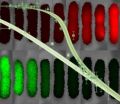(Press-News.org) ITHACA, N.Y. – Cornell University researchers report they have discovered direct genetic evidence that a family of genes, called MicroRNA-34 (miR-34), are bona fide tumor suppressors.
The study is published in the journal Cell Reports, March 13.
Previous research at Cornell and elsewhere has shown that another gene, called p53, acts to positively regulate miR-34. Mutations of p53 have been implicated in half of all cancers. Interestingly, miR-34 is also frequently silenced by mechanisms other than p53 in many cancers, including those with p53 mutations.
The researchers showed in mice how interplay between genes p53 and miR-34 jointly inhibits another cancer-causing gene called MET. In absence of p53 and miR-34, MET overexpresses a receptor protein and promotes unregulated cell growth and metastasis.
This is the first time this mechanism has been proven in a mouse model, said Alexander Nikitin, a professor of pathology in Cornell's Department of Biomedical Sciences and the paper's senior author. Chieh-Yang Cheng, a graduate student in Nikitin's lab, is the paper's first author.
In a 2011 Proceedings of the National Academy of Sciences paper, Nikitin and colleagues showed that p53 and miR-34 jointly regulate MET in cell culture but it remained unknown if the same mechanism works in a mouse model of cancer (a special strain of mice used to study human disease).
The findings suggest that drug therapies that target and suppress MET could be especially successful in cancers where both p53 and miR-34 are deficient.
The researchers used mice bred to develop prostate cancer, then inactivated the p53 gene by itself, or miR-34 by itself, or both together, but only in epithelium tissue of the prostate, as global silencing of these genes may have produced misleading results.
When miR-34 genes alone were silenced in the mice, the mice developed cancer free. When p53 was silenced by itself, there were signs of precancerous lesions early in development, but no cancer by 15 months of age. When miR-34 and p53 genes were both silenced together, the researchers observed full prostate cancer in the mice.
The findings revealed that "miR-34 can be a tumor-suppressor gene, but it has to work together with p53," Nikitin said.
In mice that had both miR-34 and p53 silenced concurrently, cancerous lesions formed in a proximal part of the prostrate ducts, in a compartment known to contain prostate stem cells. The early lesions that developed when p53 was silenced alone occurred in a distal part of the ducts, away from the compartment where the stem cell pool is located. This suggested there was another mechanism involved when p53 and miR-34 were jointly silenced.
Also, the number of stem cells in mice with both p53 and miR-34 silenced increased substantially compared with control mice or mice with only miR-34 or p53 independently silenced.
"These results indicated that together miR-34 and p53 regulate the prostate stem cell compartments," said Nikitin.
This is significant, as cancer frequently develops when stem cells become unregulated and grow uncontrollably, he said.
Researchers further found that p53 and miR-34 affect stem cell growth by regulating MET expression. In absence of p53 and miR-34, MET is overexpressed, which leads to uncontrolled growth of prostate stem cells and high levels of cancer in these mice.
Future work will further examine the role of p53/miR-34/MET genes in stem cell growth and cancer. The findings have implications for many types of cancer.
INFORMATION:
The study was funded by the National Institutes of Health, New York State Stem Cell Science, Deutsche Krebshilfe grant, the Cornell Comparative Cancer Biology Training Program and a Cornell Vertebrate Genomics scholarship.
A gene family that suppresses prostate cancer
2014-03-13
ELSE PRESS RELEASES FROM THIS DATE:
An equation to describe the competition between genes
2014-03-13
In biology, scientists typically conduct experiments first, and then develop mathematical or computer models afterward to show how the collected data fit with theory. In his work, Rob Phillips flips that practice on its head. The Caltech biophysicist tackles questions in cellular biology as a physicist would—by first formulating a model that can make predictions and then testing those predictions. Using this strategy, Phillips and his group have recently developed a mathematical model that accounts for the way genes compete with each other for the proteins that regulate ...
Study finds that social ties influence who wins certain Hollywood movie awards
2014-03-13
WASHINGTON, DC, March 13, 2014 — When it comes to Oscars and some other Hollywood movie awards, who your friends are affects whether you win, according to a new study.
"Sociological theory suggests that the process of 'making it' in any field depends not only on individual merit, but also on the kind of audience that makes the judgments," said co-author Paul D. Allison, a sociology professor at the University of Pennsylvania. "Specifically, our study found that peers are more likely to favor award candidates who are highly embedded in the field, whereas critics will not ...
Study proposes new ovarian cancer targets
2014-03-13
PROVIDENCE, R.I. [Brown University] — In the complex genomic and molecular conspiracy that gives rise to ovarian cancer, what if researchers have been missing a whole set of suspects because they've been hiding in plain sight? That's the argument made by Brown University biologists in a new paper that combines evidence from original research and prior studies to raise new suspicions about a set of proteins that assist in regulating gene expression.
Scientists need such new leads in their investigation of ovarian cancer, the most deadly reproductive cancer. Mortality has ...
UCLA study yields more accurate data on thousands of years of climate change
2014-03-13
Using a cutting-edge research technique, UCLA researchers have reconstructed the temperature history of a region that plays a major role in determining climate around the world.
The findings, published online Feb. 27 in the journal Nature Geoscience, will help inform scientists about the processes influencing global warming in the western tropical Pacific Ocean.
The study analyzes how much temperatures have increased in the region near Indonesia, and how ocean temperatures affect nearby tropical glaciers in Papua New Guinea and Borneo. Researchers also evaluated ...
Migration in China: Shifting slightly, but still going strong
2014-03-13
The brain drain of educated workers is still felt most severely in China's central and western provinces, since most knowledge-based industries are generally concentrated in its large coastal cities. However, low-educated migrant workers increasingly find jobs in their home provinces in the central and western regions because of changing economic and government policy. So says Ye Liu and his colleagues of The Chinese University of Hong Kong in Hong Kong and The University of Leeds in the United Kingdom, who carried out a systematic analysis of migration trends in China ...
Mount Sinai scientists discover how Marburg virus grows in cells
2014-03-13
New York, NY – A protein that normally protects cells from environmental stresses has been shown to interact Marburg virus VP24, allowing the deadly Marburg virus to live longer and replicate better, according to a cell culture study led by scientists at the Icahn School of Medicine at Mount Sinai. The investigators say that deciphering the molecular details of how Marburg virus and the host protein interact may help in developing inhibitors of the virus. Results from the study are published online March 13 in the peer-reviewed journal Cell Reports.
Infections with Marburg ...
Commonly used pain relievers have added benefit of fighting bacterial infection
2014-03-13
Some commonly used drugs that combat aches and pains, fever, and inflammation are also thought to have the ability to kill bacteria. New research appearing online on March 13 in the Cell Press journal Chemistry & Biology reveals that these drugs, better known as NSAIDs, act on bacteria in a way that is fundamentally different from current antibiotics. The discovery could open up new strategies for fighting drug-resistant infections and "superbugs."
"We discovered that some anti-inflammatory drugs used in human and veterinary medicine have weak antibiotic activity and ...
Extinct California porpoise had a unique underbite
2014-03-13
Millions of years ago, the coast of California was home to a species of porpoise distinguished from its living relatives by a lower jaw that extended well beyond the upper, according to researchers who report their findings in the Cell Press journal Current Biology on March 13. In other words, the long-lost porpoise had a rather distinct and unusual underbite.
Careful analysis of the fossilized Semirostrum ceruttii skull also shows that the porpoise's pronounced beak included innervated jaws, which the animal likely used to feel for prey along the ocean floor.
"The ...
Humans' ability to digest milk stems from the advent of cattle domestication in Africa
2014-03-13
Most people lose the ability to digest the milk sugar lactose after weaning, but some populations retain high levels of an enzyme called lactase, which allows them to break down lactose in adulthood. In a study published March 13th in the American Journal of Human Genetics, researchers identified genetic factors associated with lactase persistence in African populations and found that this trait became more prevalent in recent history in conjunction with the introduction and spread of cattle domestication in Africa. The findings provide strong evidence that lactase persistence ...
A versatile mouse that can teach us about many diseases and drugs
2014-03-13
Scientists from the UK and Australia have created a mouse that expresses a fluorescing 'biosensor' in every cell of its body, allowing diseased cells and drugs to be tracked and evaluated in real time and in three dimensions.
This biosensor mimics the action of a target molecule, in this case a protein known as 'Rac', which drives cell movement in many types of cancer. Rac behaves like a switch, oscillating on the molecular level between two states – active or inactive.
When Rac is active, the biosensor picks up chemical cues and glows blue. When Rac is inactive the ...




